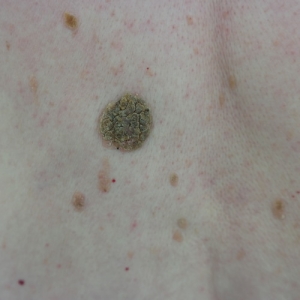Sebhorrhoeic Keratosis vs Melanoma
 A seborrhoeic keratosis can be quite a worrying skin blemish.
A seborrhoeic keratosis can be quite a worrying skin blemish.
Many people have concerns that they’re cancerous, as they look quite distinct to the normal skin.
They tend to be slightly raised and can sometimes protrude so much that they start to catch on clothing and become easily irritated.
Due to an excess of pigment, they also tend to be a much darker colour than the normal skin tone, looking brown or even black against the surrounding skin.
The texture of a seborrhoeic keratosis can also cause concern, as it looks crinkly or wart-like. Its rough texture with folds or dimples can make the blemish even more noticeable than its colour or size.
In terms of dimensions, seborrhoeic keratosis can grow to several centimetres.
Is seborrheic keratosis cancerous?
The good news is that seborrheic keratosis is NOT a form of skin cancer. So although it looks peculiar and worrying, it does not require any urgent surgery. The NHS won’t treat seborrhoeic keratoses as they’re deemed of no medical concern.
However, it is vitally important to get a proper diagnosis, as seborrhoeic keratoses can look very similar to melanoma. Both can be brown/black and can appear anywhere on the body. However, melanoma is a form of skin cancer that requires urgent treatment and therefore it’s important to get this diagnosed and ruled out as soon as possible.
How do you tell seborrheic keratosis from melanoma?
While they can look similar, there are some differences to look for:
- A melanoma is usually a single lesion, whereas patients more often get multiple seborrhoeic keratoses
- Melanomas tend to have a smooth surface, whereas seborrheic keratoses tend to be rough with a warty texture
- A melanoma often has a jagged or uneven border, while seborrheic keratoses tend to be quite well-defined
- Melanomas are often an odd shape, whereas seborrhoeic keratoses tend to be uniform
- Melanomas often have complex discoloration with more than one colour, whereas seborrhoeic keratoses tend to be a single uniform colour tone
- Melanomas can grown and change quite quickly, whereas seborrhoeic keratoses tend to be much less active and change more slowly
How do I get a diagnosis?
Seborrhoeic keratosis is diagnosed in one of 3 ways:
- Visual examination – an experienced skin doctor or dermatologist can often identify a seborrheic keratosis with the naked eye and this is usually the first step towards diagnosing what sort of blemish or skin lesion you have. They’re always alert to any sign of melanoma and if in doubt then they’ll take a further look
- Dermascope inspection – if a visual examination is not conclusive, then doctors will use a device called a dermascope for a much closer examination. A dermoscope is a small, handheld device which provides magnification as well as lighting. This gives a much better view of the skin lesion for closer inspection
- Histology Testing (biopsy) – if there is any suspicion about the lesion being cancerous, then a sample can be sent for testing. At Cosmedics Skin Clinics, all moles and any other worrying skin lesions that are removed are sent for testing as a point of best practice. Usually this just serves to put everyone’s mind at rest, but where there is an issue, it enables the appropriate referrals/treatment to commence
Your first port of call can be to the GP to get a free assessment of your skin lesion.
Alternatively, if you believe it is likely to be deemed ‘cosmetic’, then treatment and removal is only now available at private companies such as Cosmedics Skin Clinics, where experienced doctors and surgeons can diagnose and treat a vast range of skin lesions and blemishes.
Private Skin Blemish Diagnosis & Removal
The London Mole Removal Centre is a private company, offering diagnosis and treatment for skin lesions including moles, cysts, skin tags, warts, verruca, lipoma, xanthelasma, milia. All consultations and treatments are carried out in person by doctors who are specially trained in the latest laser and skin surgery techniques and are highly experienced in the field. Patients benefit from:
- No waiting lists
- Fully trained doctors, registered with GMC
- Blemishes can usually be removed in the same appointment as the consultation, saving the need for a repeat visit and allowing patients to get very quick treatment
- Choice of 4 clinics in London plus one in Bristol
- Testing with report provided where necessary
For more information or to book a consultation, please complete the form on this web page or call 020 7731 3791.


